2023.08.01.42
Files > Volume 8 > Vol 8 No 1 2023
Isolation and molecular identification of washing machine bacteria and study of the effect of some detergents on their growth
1Department of Biology, College of Science, Mosul University, Mosul, Iraq;
2Department of Biology, College of Science, Mosul University, Mosul, Iraq;. E-mail: [email protected]
2,* Department of Biology, College of Science, Mosul University, Mosul, Iraq;. E-mail:[email protected]
* Correspondence: [email protected].
Available from: http://dx.doi.org/10.21931/RB/2023.08.01.42
This study aimed to isolate, molecular identify, and evaluate the antimicrobial activity of the three commercial types of household detergents; Persil (P), Arial (A), and Peros (Pe) in both forms of gel liquid and (Tate ) powder and antibiotics susceptibility test to assessed against isolates from used washing machines in Mosul city/ Iraq. A total of 46 bacterial isolates were isolated. Five isolates were designated as Kh-Am1, Kh-Am4 from the Drum part, Kh-Am3, Kh-Am6 from the Rubber door seal part and Kh-Am5 from Drain dictum; these isolates were selected for molecular identification by 16S rRNA. The 16S rRNA gene of Kh-Am1, Kh-Am3, Kh-Am4, Kh-Am5 and Kh-Am6. The disc agar diffusion method was adopted for each selected isolate using stock and diluted concentrations. After incubation at 37ₒC for 24 hours, inhibition of Aerea was recorded. The results showed that the powder and gel form detergent stock solution has more inhibitory efficacy for the assayed isolates than dilutions. Susceptibility to antibiotics assay revealed that almost all the selected isolates were resistant. Even though infectious strains were not found, opportunistic pathogens were detected. However, because many bacteria have been detected in wash water, washing items at home with it may result in microbial contamination.
Keywords: Washing machine bacteria, Washing machine environment, Detergents effect on bacteria, Antibiotic Susceptibility of washing machine bacteria.
INTRODUCTION
Within the home environment, there are many opportunities for microbial transmission and laundry service at home. Cleaning agents have been used since time immemorial to eliminate dust and odour for hygienic or medical purposes. These items include a wide variety of items.
Laundry machines are among the most widely used household application for maintaining domestic hygiene. As a result of its extensive use, laundry is one of the most popular housework tasks 1. The washing drum's technical rotation determines a washing machine's clean efficiency, the quantity of cloth with water and cleaners, and the suitable washing duration and water temperature2.
Bacteria were decreased but not wholly destroyed throughout wash cycles after entering the washing machine via contaminated clothing and influent water. In the washing machines, the washing process generates a microbiological exchange of influent water, microorganisms, biofilm-related bacteria and skin – clothing related bacteria.3, 4 . Surviving bacteria live inside the washing machine, attaching to various surfaces or being spread in the wash load throughout the wash cycle. Suppose bacteria such as Escherichia coli or Staphylococcus aureus are prevalent. In that case, household members may be at risk of complications 5. 6 describe an occurrence in a newborn intensive care unit caused by a single species of multidrug-resistant bacteria Klebsiella oxytoca ST201, which has only been controlled whenever the washing machine was removed. Moreover, the researchers indicated that modifications in washing machine design and processing are needed to reduce the accumulation of water vapor, which might contribute to the establishment of bacterial growth.
A detergent(washing powders) is a synthetic surfactant, a chemical substance used for Cleaning. Since it includes one or more surfactants, a detergent is an efficient cleaning product. A disinfectant detergent that effectively kills harmful bacteria can help people stay healthy 7 , 8.
Isolation of Bacteria
Samples were taken from four different types of washing machines used by other families in Mosul/ Iraq, for periods ranging from months to years and where various common detergents were used. Briefly, washing machine samples were taken from three parts: Rubber door seal , Drum and Drain ditch 9. Samples were taken from the previous four locations of each washing machine using sterile swab sticks (BIONOVO, Poland) and then cultured on Trypto Soy Agar (TSA),
Then the plates were incubated for 24-48 hours at 37°C; the isolates were constantly purified until pure colonies were obtained.
The Gram-staining method was used to determine microbiological properties. The total quantity of Gram-negative and gram-positive bacteria and the phenotypic form of the cells were determined by using a light microscope after preparing slides of isolates.
Five isolates were designated as Kh-Am1, Kh-Am4 from the Drum part, Kh-Am3, Kh-Am6 from Rubber door seal part and Kh-Am5 from the Drain ditch; by analyzing colony appearance and cell morphology, they matched the definition of the genera Bacillus and Lactobacillus in Bergey's Manual of Systemic Bacteriology, The 16S rRNA sequencing was used for more molecular identification.
Amplification of the 16S rRNA gene and phylogenetic trees
The isolates Kh-Am1, Kh-Am3, Kh-Am4, Kh-Am5, and Kh-Am6 were cultivated for 24 hours at 37°C using a rotary shaker with 250 rpm in falcon tube containing (20 ml) of Tryptic Soy Broth (TSB).
Then the G- spin DNA extraction kit was used to carry out the DNA extraction procedure (intron biotechnology, Korea). Using the Maxime PCR PreMix kit approach, the genes of 16S rRNA were amplified from the genomic DNA of selected isolates by polymerase chain reaction (PCR) (i-Taq).
Each reaction of PCR used Taq PCR PreMix (5µl), 1μl of 10 picomols/µl of each conserved primer 1250 F (5'- AGAGTTTGATCCTGGCTCAG- 3') and 1250R (5'- GGTTACCTTGTTACGACTT- 3') from IDT (Integrated DNA Technologies company, Canada) , DNA template(1.5µl ) and ddH2O (16.5 µl) for a 25μl total volume.
The optimal setting for the cycle of PCR amplification for gene detection is mentioned in (Table 1). To determine the outcome of PCR interactions in the presence of standard DNA and to identify the bundle size of the PCR interaction product on the agarose gel, amplification products were electrophoresed in a 1 percent (w/v) agarose gel.
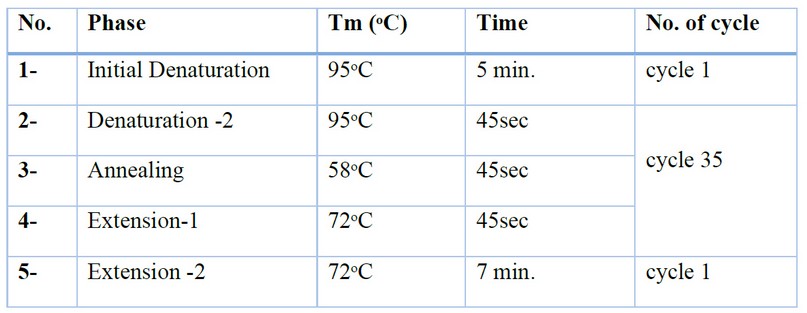
Table 1. The PCR amplification cycles under ideal conditions.
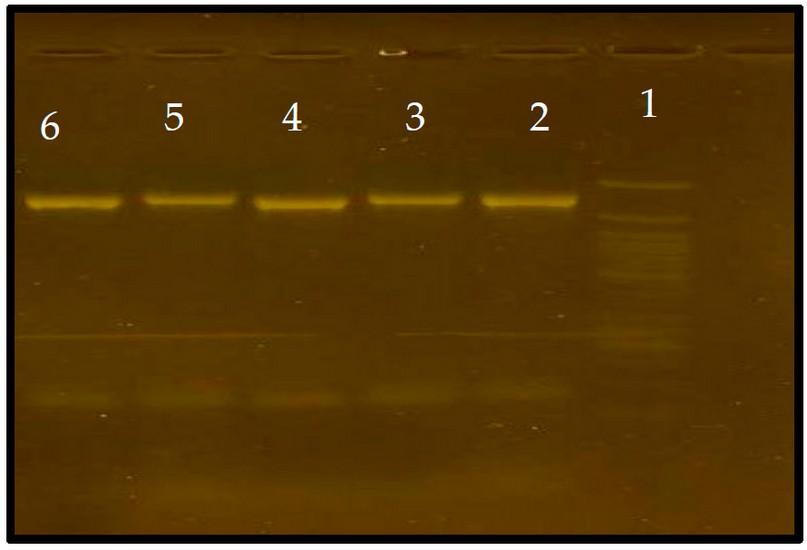
Figure 1. Electrophoresis gel of 16S rRNA gene amplified from isolates Kh-Am1, Kh-Am3, Kh-Am4, Kh-Am5, Kh-Am6, Kh-Am7. Lane 1: 1,500 bp DNA ladder; lane 2: Kh-Am1 isolate; lane 3: Kh-Am3 isolate; lane 4: Kh-Am4 isolate; lane 5: Kh-Am5 isolate; lane 6: Kh-Am6 isolate.
PCR Products Purification
The products of the PCR were purified by utilizing the PCR kit of QIAquik (QIAGEN) following the manufacturer's instructions. To mix the components, five parts of the binding buffer were added to one part of the PCR product. The mixture was placed onto a QIAquick spin column after complete mixing. The flow-through was removed, and the collecting tube was refilled with the column. DNA was cleaned using wash buffer ( 0.75 ml ) and centrifuged (30 to 60 seconds). After removing the flow-through, the tube underwent another minute of centrifugation. The column was then placed in a centrifuge tube (1.5 ml). 50 mL Elution Buffer solution was then added to the central of the QIAquik membrane for DNA elution. For a minute, the tube was centrifuged. Finally, the PCR product was purified and then sequenced by the Macro gene and the Korea Sequencing Service.
Phylogenetic relationships
The sequences of DNA collected have been compared to the database sequences of the gene bank (http://www.ncbi.nlm.nih.gov). By internet bioinformatics tools, BLAST (www.ncbi.nlm.nih.gov/BLAST), homolog surveys have been performed . Sequences shared the highest similarity with Bacillus tropicus Kh-Am1, Lacticaseibacillus rhamnosus Kh-Am3, Bacillus subtilis Kh-Am4, Lacticaseibacillus rhamnosus Kh-Am5 and Lactobacillus zeae Kh-Am6. In the format of FASTA, all the isolates have been downloaded. A maximal likelihood 10 Multiple Sequence Comparative via Log Expectation (MUSCLE) software was used to create phylogenetic trees with each 16S gene of isolates via using matched sequence and MEGA version 7.0 program. One thousand bootstrap copies of the original sequences have been used to calculate the confidence value for every branch. The complete series of 16S rRNA genes were entered into the GenBank database.
Assay of detergents activity
Microorganisms Used in the Experiment
Isolates of Kh-Am1, Kh-Am3, Kh-Am4, Kh-Am5 and Kh-Am6 bacteria were used in the experiment. Before the microbiological assay, the isolates were standardized to get the cell population of (0.5 Mac Farland standard).
Detergents
The antimicrobial potential of the detergents manufactured by different companies was investigated, and three types of detergents: Persil (P), Arial (A), and Peros (Pe) in both forms, gel liquid and (Tate ) powder, were used.
Powder (Tate) solution of the three detergent types was prepared by dissolving 0.5 g/ml to form the concentrated mixture.
(stock solution), five –fold dilutions of all the stock were then used for the following tests. Gel detergents from the original packages were considered absolute concentration (100%), andfive–fold dilutions of all the stock solution Gel were then used for the following tests.
Screening for Sensitivity
The disc agar diffusion method was adopted; for each isolate, three plates were used. One for the dilutions and two for the stock solutions (i.e., duplicated). 1 ml of the bacterial suspension for each of the following isolates: - Kh-Am1, Kh-Am3, Kh-Am4, Kh-Am5 and Kh-Am6 were placed in each sterile Petri dish, at 45°C, 19 ml sterile molten Muller-Hinton agar was poured into each of the plates that contain the suspension isolates. These were thoroughly combined and allowed to sit for a while timer: 20 minutes. Boring holes were made with a 6 mm cup borer. Each plate was divided into parts, each of which was numbered suitably. 50 mL of each stock and dilution solution was poured into the dug wells. Before incubation at 37°C for 24 hours, the plates remained at room temperature for 30 minutes.
The inhibition zone diameters that resulted were calculated and registered11,7.
Assay of antibiotic activity
The selected isolates were tested for antimicrobial susceptibility on Mueller–Hinton agar (Merck, Germany) using the disk diffusion (Kirby Bauer's) technique. Standard antibiotics were used: Penicillin G (P10 U) , Cephalexin (CL30 mcg) , Ceftazidime ( CAZ 30 mcg), Vancomycin( VA 30 mcg), Cefixime (CFM 5 mcg) from (Bioanalyse). Amount of 0.1ml from 1 ml selected isolates suspension: Kh-Am1, Kh-Am3, Kh-Am4, Kh-Am5 and Kh-Am6, using the 0.5 McFarland reference, the concentration was adjusted to roughly 1 × 108 CFU/mL were spread onto molten Muller-Hinton agar. Antibiotic discs were loaded onto the agar. After a 24-hour incubation period at 37°C, the diameter of each antibiotic's inhibitory zone was measured 12.
Swabs for attached microorganisms from the three parts of the washing machine were done. Streaking on cultured media plates revealed that the parts of the washing machine are filled with a variety of bacterial communities, table 2, with gram-positive bacteria dominating. Forty-six isolates of bacteria were collected, all of which revealed that they were more cultivable bacteria.
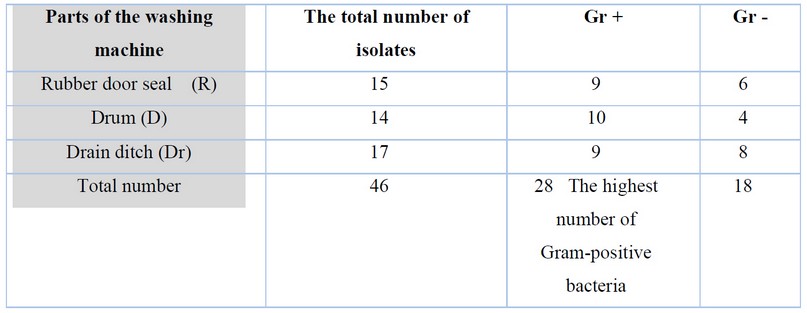
Table 2. Microflora in the washing machine parts: Rubber door seal, Drum and Drain ditch (imaging for microscope by using Gram stain).
Accession numbers for nucleotide sequences
Designated isolates as the Kh-Am1, Kh-Am3, Kh-Am4, Kh-Am5, Kh-Am6 and their ribosomal 16S gene sequences were deposited in the NCBI Genbank database under the accession numbers MW447497.1, MW447499.1, MW448431.1, MW448432.1 and MW460243.1 respectively.
Phylogenetic studies of the selected isolates
When the 16S rRNA genes of the chosen isolates were amplified and analyzed using a 1 percent agarose gel-electrophoretic method, PCR products were a size of 1500 bp (Figure 1). (http://www.ncbi.nlm.nih.gov) the search engine performed BLAST analyses on sequences of partial 16S r RNA for each isolate. All of the isolates had 98 to 100 percent sequences compared to those in the NCBI GenBank database. Neighbor-joining tree (NJ) for isolation as built-in MEGA version 7 (Fig. 2, 3). For each nucleotide position, the scale represents 0.01 substitution. P. mirabilis (KX898582) was used as an outgroup.
For the Bacillus tree (Figure 2), a neighbor-joining tree based on the sequences of 16S rRNA gene with the highest similarity showed that Bacillus tropicus Kh-Am1 and Bacillus subtilis Kh-Am4 were the most closely related to Bacillus paranthracis strain MCCC 1A00395, Bacillus nitratireducens strain MCCC 1A00732 and Bacillus tropicus strain MCCC 1A01406.
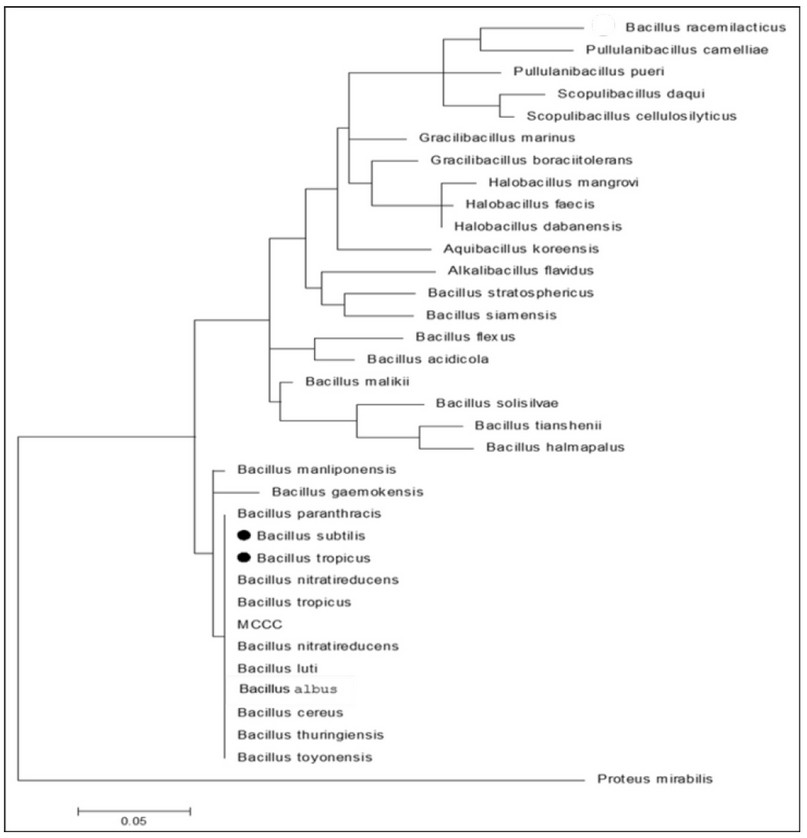
Figure 2. Neighbor-joining phylogenetic tree (1000 bootstrap) by using MEGA7 from (31 )16S rRNA sequences homologous to that of Bacillus subtilis Kh-Am4 and Bacillus tropicus Kh-Am1, respectively (indicated by black Circle).
Lacticaseibacillus isolates tree (Figure 3), showed that a neighbor-joining tree depending on the highest similarity sequences for 16S rRNA gene for Lactobacillus zeae Kh-Am6 is the most closely related to Lactobacillus zeae strain LT678023.1, while Lacticaseibacillus rhamnosus Kh-Am3 and Lacticaseibacillus rhamnosus strain Kh-Am5 were the most closely related to Lacticaseibacillus rhamnosus strain 19590 and Lacticaseibacillus rhamnosus strain 46 respectively.
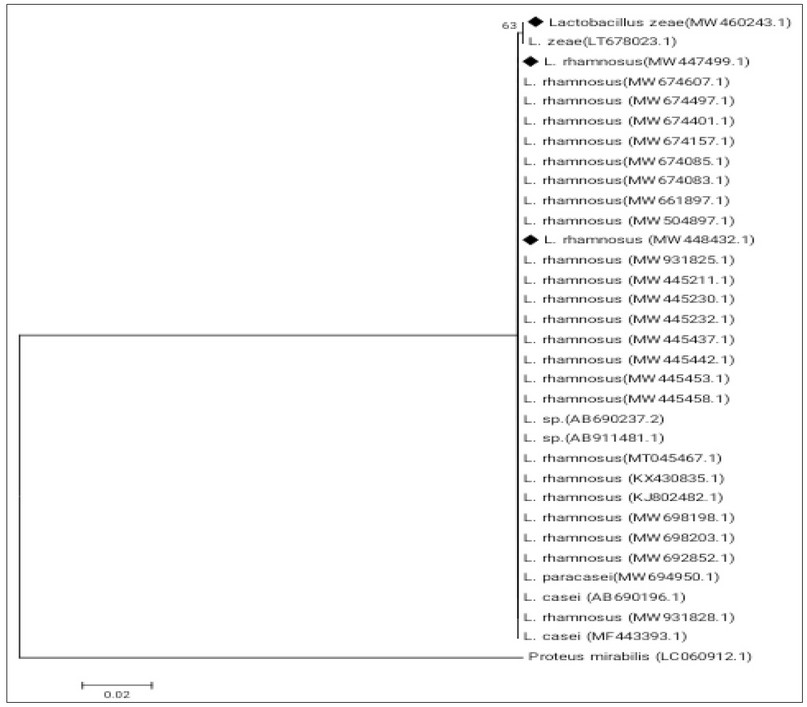
Figure 3. MEGA7 tool was used to create a neighbor-joining phylogenetic tree (1000 bootstrap) from 30 16S rRNA sequences homologous to that of Lactobacillus zeae Kh-Am6, Lacticaseibacillus rhamnosus Kh-Am3 and Lacticaseibacillus rhamnosus Kh-Am5, respectively (indicated by black rhombus).
Assay of detergents activity
The results of Table (3 ) showed that stock solution for powder has more inhibitory efficacy for five isolates than dilutions, as stock for Persil powder showed the highest inhibition of isolate Kh-Am6 with a diameter equal to 32 mm compared to other types, the lowest inhibitory diameter was for Kh-Am3 separate with a diameter equal to 13 mm for a stock for Ariel. In contrast, all the bacterial isolates showed resistance to dilutions for three types of powder detergents.

Table 3. Sensitivity (in mm) of Kh-Am1, Kh-Am3, Kh-Am4, Kh-Am5 and Kh-Am6 bacteria to the powder detergents.
The results of Table (4) showed that stock solution for gel has more inhibitory efficacy than dilutions, as stock for Ariel gel showed the highest inhibition of isolate Kh-Am3 with a diameter equal to 15 mm compared to other types, while all isolates showed resistance against the dilute concentration of three types for gel detergents except for Kh-Am6 at (15) mm inhibition diameter for gel Ariel.

Table 4. Sensitivity (in mm) of Kh-Am1, Kh-Am3, Kh-Am4, Kh-Am5 and Kh-Am6 bacteria to the gel detergents.
Assay of antibiotic activity
Table (5) shows that Kh-Am1and Kh-Am5 isolates are more resistant to the antibiotics used than other isolates, the Kh-Am4 isolate is more sensitive to antibiotics, and all isolates showed resistance to both CFM5 and CAZ 30 antibiotics.
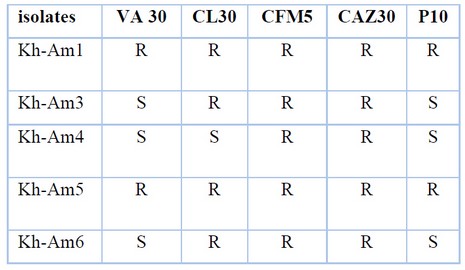
Table 5. Antibiotic susceptibility: Sensitivity of Kh-Am1, Kh-Am3, Kh-Am4, Kh-Am5 and Kh-Am6 bacteria to Vancomycin( VA 30 mcg), Cephalexin (CL30 mcg) , Cefixime (CFM 5 mcg), Ceftazidime ( CAZ 30 mcg), Penicillin G (P10 U).
Bacteria that colonies the extreme environment of ancient washing machines that have been in use for more than five years with commonly used washing machine detergents were investigated. Using cultivation-dependent approaches, swab collection from household washing machine parts (Rubber door seal, Drum and Drain ditch) was picked.
Sample collection sites were carefully selected, as they provide surfaces for collecting microbes in addition to being in contact with the washing water.
The largest number of isolates were obtained in the Drain ditch part, which is evident as it accumulates an amount of the washing water, thus forming a moist environment that helps the growth of microbes. The collected washing water is rich in elements that support the development of microbes 9.
The three most contaminated parts of the washing machine are Gram-positive bacteria compared to Gram-negative bacteria Table (1). The reasons are probably due to the ability of some bacteria, such as Bacillus, to form spores, ensuring their survival for a more extended period.
Spores are one of the most resistant life forms known to date. One of the key factors contributing to these organisms' resistance to various difficulties, such as chemicals and extreme physical conditions, is their distinctive spore structure, which can withstand temperatures 40–45 0C higher than those experienced by their vegetative cells. The inner spore membrane, the peptidoglycan cortex, and the outer protein coat surround the dehydrated spore core, with the cortex playing a crucial role in the preservation of resistance 13. Also, some bacteria such as Lactobacillus inhibit the growth of gram-negative bacteria 14. In contrast, the studies of 15, 16 mentioned that the negative bacteria are prevalent within the washing clothes and dishwasher machine community as they are more resistant to detergents(without bleaching agent), while the Gram positive bacteria are more resistant to high temperatures.
A polyphasic taxonomic analysis was used to explore five novel Gram-stain positive bacteria. These isolates belonged to the Bacillus and Lactobacillus families, according to 16S rRNA gene sequence analyses, with over 97 percent identity to recognized Bacillus and Lactobacillus species. They well-separated branches from species were recorded, according to multilocus sequence typing analyses. The neighbor-joining tree depending on the highest similarty sequences for the 16S rRNA gene, showed that the Bacillus tropicus Kh-Am1 and Bacillus subtilis Kh-Am4 were the most closely related to Bacillus paranthracis strain MCCC 1A00395, Bacillus nitratireducens strain MCCC 1A00732 and Bacillus tropicus strain MCCC 1A01406, all have been deposited in GenBank, but represent unpublished data.
Furthermore, a split network tree based on the concatenated sequences of the highest similar 16S rRNA gene was performed, and three isolates of the Lacticaseibacillus group were divided into two principal clusters: Lactobacillus zeae which Lactobacillus zeae Kh-Am6 was deposit and Lacticaseibacillus rhamnosus were Lacticaseibacillus rhamnosus Kh-Am3 and Kh-Am5 were the most closely related.
In this study, results of the detergent's sensitivity (tables 2 and 3) showed that isolates vary in their response to three different types of commercial brands tide (Peros, Ariel, Persil ) for both powder and liquid forms. The stock solution of the powder and gel for the three types of the wave has more inhibitory efficacy for five isolates than dilutions; this is consistent with what researcher 17 indicated in his study, where the maximum microbial growth at the lowest concentration of detergents, and the minimum microbial growth was recorded at the higher concentration, as the detergents contain several chemicals that enhance their antimicrobial properties.
As stock for Persil powder showed the highest inhibition of isolate Kh-Am6 with a diameter equal to 32 mm compared to other types, the lowest inhibitory diameter was for Kh-Am3 separate with a diameter equal to 13 mm for the stock for Ariel. In contrast, store for Ariel gel showed the highest inhibition of isolating Kh-Am3 with a diameter equal to 15 mm compared to other types; the study of 7 mentioned that the Ariel detergent was found to be the most active, in concentrated in addition to dilute solutions. Streptococcus pneumonia showed the highest inhibition with a diameter equal to 29 mm.
All the isolates of this study showed resistance against the dilute concentration of three types for powder and gel detergents except for Kh-Am6 at 15 mm inhibition diameter for gel Ariel. Another study of 11 mentioned that the effect of detergents does not depend only on the type of detergent; it also depends on the period of immersion and temperature, in addition to the fact that bacteria can develop biofilms since they do so frequently in washing machines.18 It is recommended to increase the washing machine program, meaning extending the drying, washing and spinning time, to get rid of the films and some plankton that may remain in the body of the washing machine, which may result in a fertile environment for the growth of microbes.
For the antibiotic activity, the study showed that most of the isolates were resistant to antibiotics, as shown in Table (4); kh-am1 and Kh-Am5 isolates showed resistance to all used antibiotics, while the Kh-Am4 isolate was more sensitive to used antibiotics. The high temperatures and continuous exposure to various types of detergents in washing led to the development of antibiotic resistance by stimulating mutations in the genetic material.
19 stated that the resistance of bacteria to antibiotics is due to chromosome mutations or direct transfer of genes encoding a resistance mechanism. Resistance genes can be transferred in various ways, including conjugation (mobile genetic elements), transduction or transformation. The conjugation between the Bacillus genus and clinically relevant pathogens is possible, resulting in the transfer of antibiotic-resistance genes 20. Perhaps the plasmid transfer in the biofilms enhances the resistance of bacteria to antibiotics and chemicals because the biofilm community is the dominant environment in washing machines 21.
The antibiotics used in this study have a common mechanism of action: to inhibit the synthesis of the peptidoglycan layer of the bacterial cell wall. Therefore these antibiotics are resistant by one of the two mechanisms, either by the enzymatic inhibition in some penicillin-resistant bacteria by synthesis of the enzyme beta-lactamase that breaks the beta-lactam ring in antibiotics or antibiotic resistance is developed through a change in the target site (antibiotic site of action) such as alteration in penicillin-binding proteins (PBP) and thus preventing binding of the antibiotic to the active site 22.
The study revealed that the washing machine was contaminated with gram-negative and gram-positive bacteria, with gram-positive bacteria dominating. This could be due to some bacteria's ability to form sporulation, which is the most life-resistant form of life that can withstand a variety of challenges, including chemicals, heat, and other harsh conditions where possible in addition to the Lactobacillus' ability to produce anti-growth of gram-negative bacteria, as well as its ability to resist temperatures surpassing 40-45° C.
Bacterial isolates had varying levels of resistance to both types of detergents, Tate and Gel, and from several commercial brands (Peros, Ariel, Persil) and also Perose cleaner is better at removing bacteria, then Ariel and Persil.
The stock solution for each powder and gel inhibited the bacteria, although all of the isolates were resistant.
Thus, the washing machine cleans the garments rather than sterilizes them. It may play a part in providing a sterile environment by lengthening the washing time, selecting the proper temperature, or selecting the detergent to minimize microbial growth in the washing machine environment.
Funding: "This research received no external funding,"
Acknowledgments: The author would like to thank Biology depart. , University of Mosul for supporting this research.
Conflicts of Interest: "The authors declare no conflict of interest."
1. Bao, W., Gong, R. H., Ding, X., Xue, Y., Li, P., & Fan, W. Optimizing a laundering program for textiles in a front-loading washing machine and saving energy. Journal of cleaner production,2017: 148, 415-421.
2. Bloomfield, S. F., Exner, M., Signorelli, C., & Scott, E. A. Effectiveness of laundering processes used in domestic (home) settings October 2013. In IntSci Forum Home Hyg (pp. 1-62).
3. Callewaert, C., Van Nevel, S., Kerckhof, F. M., Granitsiotis, M. S., & Boon, N. Bacterial exchange in household washing machines. Frontiers in microbiology,2015: 6, 1381.
4. Teufel, L., Pipal, A., Schuster, K. C., Staudinger, T., &Redl, B. Material‐dependent growth of human skin bacteria on textiles investigated using challenge tests and DNA genotyping. Journal of applied microbiology,2010: 108(2), 450-461.
5. Bloomfield, S., Exner, M., Flemming, H. C., Goroncy-Bermes, P., Hartemann, P., Heeg, P., ...&Trautmann, M. Lesser-known or hidden reservoirs of infection and implications for adequate prevention strategies: Where to look and what to look for. GMS hygiene and infection control,2015: 10.
6. Schmithausen, R. M., Sib, E., Exner, M., Hack, S., Rösing, C., Ciorba, P., ...&Exner, D. The washing machine as a reservoir for transmission of extended-spectrum-beta-lactamase (CTX-M-15)-producing Klebsiellaoxytoca ST201 to newborns. Applied and environmental microbiology,2019: 85(22).
7. Ikegbunam, M. N., Metuh, R. C., Anagu, L. O., & Awah, N. S. Antimicrobial activity of some cleaning products against selected bacteria. International Research Journal of Pharmaceutical and Applied Sciences,2013: 3, 133-135.
8. Wang, Z., Shen, Y., Ma, J., &Haapasalo, M. The effect of detergents on the antibacterial activity of disinfecting solutions in dentin. Journal of endodontics,2012: 38(7), 948-953.
9. Tabata, A., Zhang, D., Maeda, T., Nagamune, H., & Kourai, H. Microbial contamination in home laundry operations in Japan. Biocontrol Science,2003: 8(1), 9-18.
10.Felsenstein, J. Evolutionary trees from DNA sequences: a maximum likelihood approach. Journal of molecular evolution,1981: 17(6), 368-376.
11. Jouda, M. M., Dardona, Z., & Albayoumi, M. The Antibacterial Effect of Some Household Detergents Againts Staphylococcus Aureus. Int J Curr Microbiol App Sci,2016: 5(2), 459-463.
12. Zulkhairi Amin, F. A., Sabri, S., Ismail, M., Chan, K. W., Ismail, N., Mohd Esa, N., & Zawawi, N. Probiotic properties of Bacillus strains isolated from stingless bee (Heterotrigona itama) honey collected across Malaysia.2020: International journal of
13. Robinson, R. K. Encyclopedia of food microbiology. Academic press.2014.
14. Bordignon Junior, S. E., Miyaoka, M. F., Spier, M. R., Rubel, R., Soccol, V. T., & Soccol, C. R. Production biomolecule with inhibitory activity against Gram-negative bacteria isolated from faeces of broilers and swine. Brazilian Archives of Biology and Technology,2011: 54(4), 723-731.
15. Nix, I. D., Frontzek, A., & Bockmühl, D. P. Characterization of microbial communities in household washing machines. Tenside Surfactants Detergents,2015: 52(6), 432-440.
16. Younis, K. M., Matter, I. R., & AL-Omari, A. W. Isolation and Molecular Identification of Bacillus boroniphilus sp. nov., Isolated from Dishwasher. Annals of the Romanian Society for Cell Biology,2021: 12286-12295.
17. Bhat, R., Prajna, P. S., Menezez, V. P., & Shetty, P. Antimicrobial activities of soap and detergents. Adv Biores,2011: 2(2), 52-62.
18. Gattlen, J., Amberg, C., Zinn, M., & Mauclaire, L. Biofilms isolated from washing machines from three continents and their tolerance to a standard detergent. Biofouling,2010: 26(8), 873-882.
19. Banoon, S., Ali, Z., & Salih, T. Antibiotic resistance profile of local thermophilic Bacillus licheniformis isolated from Maysan province soil. Comunicata Scientiae,2020: 11, e3921-e3921.
20. Dworkin, M. The Prokaryotes: Vol. 3: Archaea. Bacteria: Firmicutes, Actinomycetes. Springer Science & Business Media.2006.
21. Stalder, T., & Top, E. Plasmid transfer in biofilms: a perspective on limitations and opportunities. NPJ biofilms and microbiomes,2016:2(1), 1-5.
22. Drawz, S. M., & Bonomo, R. A. Three decades of β-lactamase inhibitors. Clinical microbiology reviews,2010: 23(1), 160-201.
Received: December 23, 2022 / Accepted: January 30, 2023 / Published:15 February 2023
Citation: Al-Ani A G O, Younis K M, Al-Taee S M Y . Title. Isolation and molecular identification of washing machine bacteria and study the effect of some detergents on their growth. Revis Bionatura 2023;8 (1)42. http://dx.doi.org/10.21931/RB/2023.08.01.42
